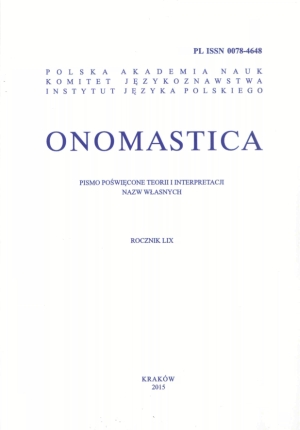Streszczenie
A Classification of Ukrainian Surnames Derived from the Proper Names of Persons on the Basis of Appearance
This investigation focuses on the modern Ukrainian surnames derived from a person’s appearance. The author analyzed different approaches to the systematization of such surnames that were applied in onomastic research, finding some differences in these classifications. For example, there is some controversy as to the scope (content) of this group. For example, some investigators do not include surnames derived from proper names of persons on the basis of their strength, health, clothing and so on as a part of this group surnames. On the other hand, some other researchers believe that it is necessary. Doubts have also been expressed as to the appropriacy of including some surnames which are derived from the names that described the gait of the person or their gender.
Developing our approach to the classification of surnames derived from the proper names of persons on the basis of appearance, the author used the achievements of gabitology that uses characteristics of human appearance for the identification of the person. Fixed surnames were distributed according to the semantics of lexemes in the following subgroups: general physical (they can characterize the appearance of the person in general), anatomical (they can characterize body type, organs of the human body) and functional (characteristics of human appearance that are seen in mo- tion). Surnames were also differentiated within each subgroup. For example, the author identified the surnames derived from the proper names whose meaning are connected with the features of human growth, body type (skinny build, slim build, chunky, fat), unusual shape, size, and color of organs of the human body. The important thing to note is that the namegivers focused on those characteristics of human appearance that were original, relatively constant, and helped to identify a person.
Bibliografia
Babìj, Û. (2007). Prìzviŝa sučasnoï Seredn’oï Naddnìprânŝini. [Dis. … kandidata nauk, Mikolaïvs’kij deržavnij unìversitet ìm. V. O. Suhomlins’kogo].
Bìlenčuk, P. (red.). (2001). Krimìnalìstika (krimìnalìstična tehnìka). Kiïv: MAUP.
Bìlodìd, Ì. (red.). (1970–1980). Slovnik ukraïns’koï movi. T.1–11. Kiïv: Naukova dumka.
Blažčuk, Û. (2008). Antroponìmìâ Umanŝini XVII–počatku XXI st. [Dis. … kandidata nauk, Umans’ki deržavnij pedagogìčnij unìversitet ìm. P. Tičini].
Bulava, N. (2005). Sučasnì ukraïns’kì prìzviŝa pìvnìčnoï Doneččini. [Dis. … kandidata nauk, Odes’ij nacìonal’nij unìversitet ìm. Ì. Ì. Mečnikova].
Čučka, P. (2005). Prìzviŝa zakarpats’kih ukraïncìv: Istoriko-etimologìčnij slovnik. L’vìv: Svìt.
Čučka, P. (2011). Slov`âns’kì osobovì ìmena ukraïncìv: Istoriko-etimologìčnij slovnik.Užgorod: Lìra.
Da l’, V. (1881). Tolkovyj slovar’ živago velikoruskago âzyka. T. 2: I–O. Sankt Peterburg–Moskva: Tip. M. O. Vol’fa.
Êfimenko, Ì. (2003). Ukraïns’kì prìzviŝevì nazvi XVI st. Kiïv: Polìgraf dìl’nicâ Ìnstitutu ìstorìï Ukraïni NAN Ukraïni.
Grìnčenko, B. (1958). Slovnik ukraïns’koï movi. T. 1–4. Kiïv: Vid-vo Akademìï nauk Ukraïns’koï RSR.
Ìl’čenko, Ì. (2003). Antroponìmìâ Nižn’oï Naddnìprânŝini v ïï ìstoričnomu rozvitkovì (Nadvelikoluz’kij regìon). [Dis. ... kandidata nauk, Zaporìz’kij deržavnij unìversitet].
Kravčenko, L. (2002). Antroponìmìâ Lubenŝini. [Dis. … kandidata nauk, Kiïvs’kij nacìonal’nij unìversitet ìm. T. Ševčenka, 2005].
Mel’ničuk, O. (red.). (1982–2012). Etimologìčnij slovnik ukraïns’koï movi. T. 1–6. Kiïv: Naukova dumka.
Novikova, Û. (2008). Semantiko-slovotvìrna struktura prìzviŝ Central’noï ì Shìdnoï Doneččini. [Dis. ... kandidata nauk, Odes’kij nacìonal’nij unìversitet ìm. Ì. Ì. Mečnikova].
Padalka, R. (2009). Dinamìka prìzviŝ Slov`âns’kogo r-nu Donec’koï oblastì (kìnec’ XIX–počatok XXI st.). [Dis. ... kandidata nauk, Slov’âns’kij deržavnij pedagogìčnij unìversitet].
Red’ko, Û. (1966). Sučasnì ukraïns’kì prìzviŝa. Kiïv: Naukova dumka.
Rul’ova, N. (2004). Antroponìmìâ Zahìdnogo Podìllâ kìncâ XVIII–XX st. [Dis. ... kandidata nauk, Černìvec’kij nacìonal’nij unìversitet ìm. Û. Fed’koviča].
Savčenko, V. (2000). Avantûristy graždanskoj vojny: Istoričeskoe rassledovanie. Har’kov: Folio.
Sorokaletov, F. (red.). (1965–2014). Slovar’ russkih narodnyh govorov. T. I–XLVII. Sankt-Peterburg: Nauka.

